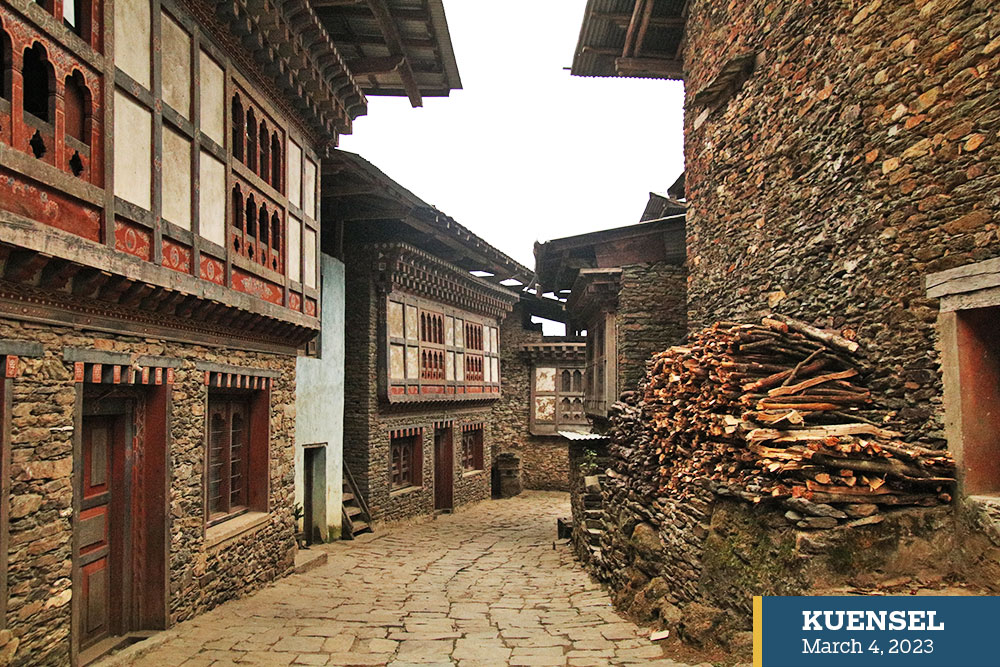Chhimi Dema
The Trong Heritage Village in Zhemgang has a soul and a picture of its own. It is a unique village that harkens back to medieval Bhutan when architectural grandeur flourished.
What skills the masons and builders possessed then and envisioned the fabric of the community is a thing of the past. As you walk through the gullies and open spaces of the villages, history sings in full orchestral splendour.
When did the village come to be? No one knows.
The best guess is that it could have been around the 16th century during the time of Lama Zhang Dorje Drakpa.
It is said that one Lama Zhang came to Bhutan from Tibet in the 12th century. In 1655, he built a hermitage where Zhemgang Dzong stands today, which was then known as Zhang Gang (meaning Lama Zhang’s hill).
The Trong village today has 27 households.
Tandi, 80, says the village has seen little change over the years. Earthquakes have not been able to cause damage to the houses in the village.
But the fire is a big concern.

The village was recognised as a heritage site in 2014
Tandi reminisces: “His Majesty the Second King was walking through the village. It was a spectacular experience for me. I still remember the day vividly.”
According to Tandi, the path in the village was a Zhung Lam, trailed by kings, officials, business people, and farmers then. “This was the only route to Gelephu.”
Yeshi Samdrup of the Department of Culture and Dzongkha Development says that the settlement pattern of the heritage village–with houses constructed along a well-defined avenue–is unique which qualifies it as a heritage site.
“Such settlement pattern is unique in the country,” says Yeshi Samdrup.
The heritage village is clustered on either side of a cobbled path running through the village unlike the common settlement pattern (clustered, semi-clustered and scattered) seen in Bhutan.
Yeshi Samdrup says one such settlement pattern can be seen in Korphu village in Trongsa. But, the houses are built from different materials like mud and stone, whereas the houses in the Trong heritage village are made only with stones.
Tashi Tshering, an architect with the department, says that the heritage village is unique as the houses are built on topography without landscaping. “The houses were raised on the land as it was with traditional architecture values.”
The department carried out a population demographic study and documented three houses from the village recently.
Trong as the heritage village
Dzongkhag officials said that the village was recognised as a heritage site in 2014 when His Majesty The King visited the village.
“The households can make changes to the inside of the houses but the architect outside cannot be changed,” an official said.
The heritage village faces shortage of water, lack of sanitation, and risk of fire outbreaks today.
The dzongkhag is rooting for the Department of Culture and Dzongkha Development’s management plan to improve sanitation and other facilities at the heritage village.
Management Plan of Trong Heritage Village
The department of culture will implement the Management Plan of Trong Heritage Village in July this year.
Yeshi Samdrup said that the management plan guides development in the village. “The plan is not to freeze the livelihood opportunities of the people.”
The management plan is aimed to increase the value of the heritage village by providing the households with technical support to rehabilitate current structures.
Yeshi Samdrup said that heritage sites are important to show the country’s identity and strengthen sovereignty.
The department has identified Nobgang, Nabji-Korphu, and Trong as heritage villages in Bhutan.
This story is supported by GEF-UNDP Ecotourism Project under the Department of Tourism.


